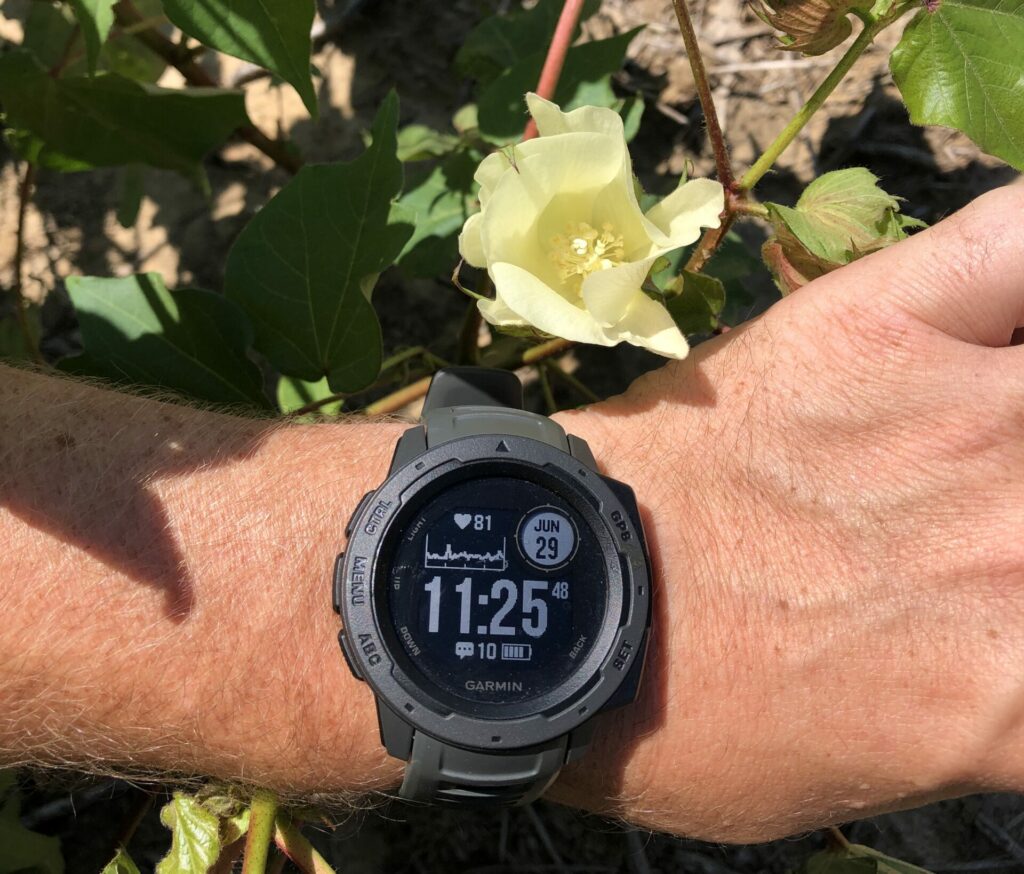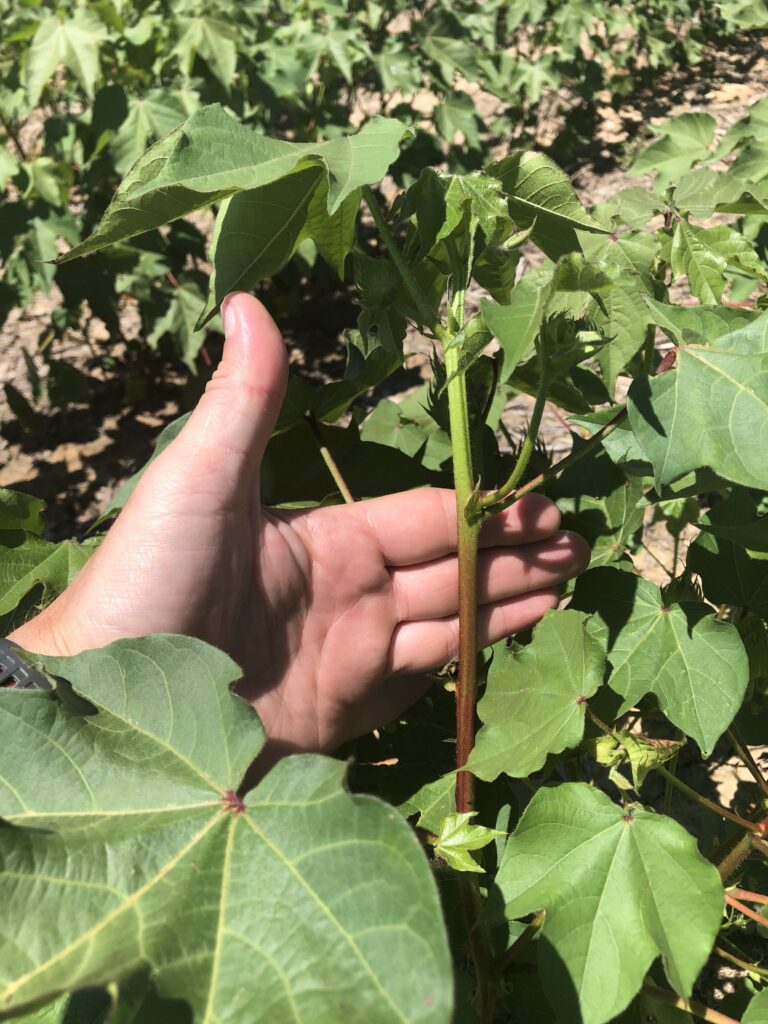 More times than not, when a cotton planter left a TN field in 2022, a thunderstorm bringing ~2″ of rain and cool weather would arrive 3 days later. I’ve walked more replants this year than ever before and unfortunately the old saying ‘if you are on the fence, keep it’ rarely applied; in many fields, we weren’t anywhere near the metaphorical fence. Still, Tennessee’s ragged cotton crop has generally turned the corner and mid and late June have been cotton weather; our earliest cotton reached early bloom well prior-to the 4th. In this blog, I cover a few things to keep in mind as we begin to apply PGRs to more acres and look to push a few slower farms into ‘taking off’.
More times than not, when a cotton planter left a TN field in 2022, a thunderstorm bringing ~2″ of rain and cool weather would arrive 3 days later. I’ve walked more replants this year than ever before and unfortunately the old saying ‘if you are on the fence, keep it’ rarely applied; in many fields, we weren’t anywhere near the metaphorical fence. Still, Tennessee’s ragged cotton crop has generally turned the corner and mid and late June have been cotton weather; our earliest cotton reached early bloom well prior-to the 4th. In this blog, I cover a few things to keep in mind as we begin to apply PGRs to more acres and look to push a few slower farms into ‘taking off’.
With the exception of this past Sunday (6/26), the past three weeks represent what I believe is an ideal June for cotton. We talk quite a bit about heat units and we’ve accumulated plenty during June, but it is important to remember that the ideal growing temperatures for cotton may fall as low as 55F at night and around 86F during the day. Considering those thresholds, even the past couple of cooler days have been excellent for our crop. Dry conditions prior to bloom, in my opinion, drive root growth deeper into the ground and push the plant into flowering. All of this helps manage vegetative, above-ground plant growth naturally. Even though it has been hot through much of the month, humidity and temps at night have generally been low so few of our photosynthates have been wasted through nighttime respiration. Again, if I were to ask for a ‘cotton’ June, it would look like our last three weeks.
Because of those conditions, PGR applications on the majority of our acres have not been warranted and I have hesitated to recommend them even on bottom ground. My main concern has been lack of rainfall in the forecast. A strong application (an ounce per node at 2nd-3rd week of square, for example) can hurt even the most aggressive growing variety if the plant is in need of water.
I hesitate to mention it, let alone plan for it, but rain chances over the weekend and into next week look good; drier conditions look like they will break and we will fall into a more normal, humid, scattered thunderstorm pattern. I fully expect PGRs to be needed by the end of next week but we should have an easier time managing growth this year compared to last year because of this year’s June.
How do we get started? First, figure out current growth rate of the plant. At times, we make this more complicated than it should be. Find the most recently expanded internode in the top of the plant, usually between the 3rd and 4th OR 4th and 5th nodes. After you find that internode, rest your ring finger on the lower node and note the position of the upper node to your index finger. If this node is less than 2″, an application is not warranted. If it is between 2-3″, a light or moderate application may be warranted. If it is longer than 3″, an aggressive application is warranted in most situations. Most people don’t carry a tape measure with them at all times, so the three finger rule does a pretty good job of giving you a rough estimate of this distance. Measuring the uppermost, most recently expanded internode is the best way to capture current growth potential. Height to node ratio of the entire plant gives insight into the average of growing conditions and previous regulation and subsequently is not a great measurement of current growth potential (often referred to as horsepower). We can’t change the past (shorten previously expanded internodes) but we can change the future (internode expansion yet to occur). 
Second, figure out the growth potential and responsiveness to PGRs of your variety. The MidSouth Cotton Specialists’ Working Group compiled a variety list that I posted on the blog earlier this week. You can access that list by following this link. We have considerable variation in response to plant growth regulators in our most commonly planted varieties and failing to adjust rate based on variety will cost you in the end.
Finally, consider the current growing environment and what you expect might be coming. If it is a fertile bottom that tends to grow rank with rainfall in the forecast, I would lean towards a more aggressive application. If it is thin ground that tends to be weak and only slight chances of rain are forecast, lighter applications or no application at all may be warranted.
IF we are able to capture over an inch of rain with this next system AND rain chances remain in the forecast, I would consider getting started on acres that are around 8 to 10 nodes. Below I’ve listed my 2022 approach on cotton that will soon flower or where blooms are just beginning to appear. ALL RATE RECOMMENDATIONS ARE BASED ON A 4.2% mepiquat chloride product. Please note that 6x products would require you to reduce my recommended rates by 1/6th.
With an aggressive variety on strong ground with rain in the forecast, I would feel comfortable running one ounce per node per acre between 8 nodes and first flower. After first flower, if the environment continues to support strong growth, I would consider a 12-16 oz application within 14 days of the first application. Additional applications (near peak bloom) may require 16-24 oz to regulate growth.
With a moderate or passive variety on strong or moderate ground with rain in the forecast, I would not exceed 6 oz per acre of a 4.2% product until after first flower. After first flower, I would consider an 8-12 oz application within 14 days of the first application. Additional applications (near peak bloom) will likely require no more than 16 oz to regulate growth.
With a passive variety on weak ground with rain in the forecast, I would not apply PGRs prior to first flower. After first flower, an 8-12 oz application within 14 days of first flower should bring growth into an acceptable range. Additional applications will likely not be required.
At this point, we still have plenty of time and room on the label to apply an aggressive application during mid bloom to drastically slow growth, should we undershoot rate. Continuously monitor expansion of the most recently expanded internode and adjust rate or timings based on the current growth potential. If the forecast breaks dry again and growth slows with internodes under 2″ or between 2-3″, rates should again fall or applications may need to stop.
A few of you will likely note that your initial rates have likely been higher in prior years than the ones I mentioned. Again, in most areas, mother nature has restrained growth so lower rates are currently warranted. Finally, I’m very hesitant to apply PGRs at any rate to 2, 4 or 6 leaf cotton; I want a minimum of 8-10 nodes before I apply PGRs. In fields where the planter touched up thin stands, 4 leaf cotton is currently adjacent 8-10 node cotton. I know the older cotton has triggered an application but I would delay the application and reduce the rate when I did apply so I don’t overly restrict growth of the younger plants.
One last point- we occasionally make these decisions more complicated than they have to be. The good news is plant height and yield potential don’t go hand in hand- 32″ cotton regularly picks the same as 42″ and 52″. Be sure to not end up on either extreme (really short or really tall) and it’ll generally work out.
Hope everyone has an excellent and safe 4th!

